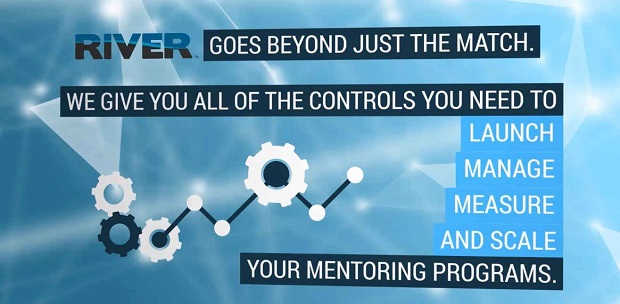* – This article has been archived and is no longer updated by our editorial team –
Below is our recent interview with Chris Browning, President of River:

Q: How has mentoring changed over the past couple of decades, particularly as technology came into play?
A: Mentoring has always been about people coming together to learn from one another. Technology does not change that, but it does expand how people can connect, meet up, collaborate, and so on.
Corporate mentoring has been around in full force since the 1980s, when there was a push to get more women into leadership. Sadly, that need still exists today, so we continue to see a large amount of interest in mentoring to address diversity and inclusion issues, particularly as a result of the #MeToo and #MentorHer movements. We also see a lot of interest in mentoring to help with leadership development, career development, training support, and the like. Back in the ‘80s, the mentees were young professionals who were matched with older leaders. The person running the program would match everyone by hand and the pairs would meet in person for face-to-face meetings.
As with everything over the past few decades, technology has changed how we work, communicate, and engage with the world around us. People aren’t limited to face-to-face meetings anymore. Nor are administrators limited to running a program by literally using a spreadsheet to try to match hundreds or thousands of people into mentoring relationships. Nowadays, people can use mentoring software like River to run and manage their mentoring programs. The matching algorithm in River lets administrators configure and automate the matching process, greatly reducing the administrative burden that accompanied that process in the past. It also allows organizations to offer mentoring to more employees because of the scalability and cost-effectiveness of it. Companies can now bring mentoring to the masses, rather than having it be a practice for just the elite.
Technology has also helped organizations take advantage of group mentoring, reverse mentoring, and peer mentoring; and with River, an organization can make use of all of those types of mentoring within the software at the same time. They can track progress, run reports, share resources, and streamline their entire program into one technology solution. It really all comes down to making things easier on mentees, mentors, and administrators.
 Recommended: Personalized Proactive Health Platform iamYiam Empowers People To Take Charge Of Their Health
Recommended: Personalized Proactive Health Platform iamYiam Empowers People To Take Charge Of Their Health
Q: Does mentoring software make mentoring impersonal?
A: Absolutely not. Mentoring software does not make mentoring impersonal. Because mentoring is about two or more people coming together to learn from one another, mentoring will always be personal. The only thing mentoring software does is makes it an easier and more efficient process to partake in. For example, nearly all of our clients over the past two decades came to us because they were hand-matching their participants and they needed a better way to match people up in relationships. Because of our matching algorithm, people can quickly and easily find the ideal match for their mentoring needs. Organizations can run multiple mentoring programs at once, and they can configure the matching algorithm independently for each mentoring program they run. When they configure the matching algorithm, they can take into account criteria such as:
• Alignment between the mentee’s competency/skill development needs and the expertise and experience of available mentors
• Organizational demographics (e.g., business unit/department, role, location/geography)
• Personal demographics (e.g., gender, race, ethnicity)
This means that for every mentoring program that the client runs, they can make the matching algorithm unique for each audience. That is huge! This means that mentees and mentors are going to find a great match much more quickly and easily because of technology.
Q: What are the benefits to using software to facilitate mentoring relationships?
A: The whole point of using mentoring software is to make it easier and simpler to engage in mentoring relationships, and then to subsequently report on them. For example, software means that mentees and mentors can find a mentoring partner more quickly and easily compared to having to network on their own. They can log into River and know that the people they match up with via the software are people who have stepped forward and said that they wanted to be in a mentoring relationship. This is much more effective than having to cold call someone to ask them to be your mentor.
The benefits that come from matching capabilities in mentoring software can occur in one-to-one relationships, as well as in mentoring groups or mentoring circles. Software makes it easy to find groups focused on specific learning needs or interest areas that can meet a person’s development needs, and then people can quickly join these groups to start learning from experts and peers. Additionally, administrators can easily start groups aligned with specific organizational initiatives, such as using group mentoring to supplement a training event so that people continue to learn from one another even after the actual class ends. Once people are in a mentoring relationship, be it one-to-one or group, software can be used to share resources, post comments and questions, and interact with one another. This keeps all of the information catalogued within the confines of that specific relationship.
Q: How does River mentoring software assist the administrators and the people who actually run the mentoring programs at your client organizations?
A: Mentoring programs don’t just run themselves; there are people in the background doing a lot of work to make them a success. The mentoring program administrators at our client organizations deserve a lot of credit for the work that they do. We’re committed to making their jobs easier with our software and have developed some great features within River to do so. Here are some examples.
Matching Algorithm: Our matching algorithm and capabilities in River are one of the main attractions for our clients. Many people are still manually running their programs and hand-matching their mentees and mentors using spreadsheets—even in 2018. Yet with River, that entire process can be automated and streamlined, making the administrator’s job much easier.
Companies can run multiple mentoring programs at the same time using River, and each program can be configured with various specifications. This means that administrators can configure and weight the matching algorithm and user profile fields for each program, allowing for greater flexibility in how matches are made per program. For example, they might want to make sure that mentors in an onboarding program are in the same business unit as the mentee. Contrastingly, in a certain type of leadership development program, a secondary goal may be to promote cross-functional connections, and in that case, the administrator wants to ensure the mentors come from a different business unit than the mentee. Administrators are able to configure the matching algorithm to make matches based on these types of criteria and weight it as the most important factor of the match. This gives the administrators even more control over how matches are made for their specific program.
Matching can take place in River via administrator matching, self-directed matching, and facilitated matching. Within the admin-matching option, administrators can hold and review multiple potential matches before finalizing the selections. This lets administrators make and subsequently review tentative matches, allowing them to adjust their choices prior to releasing the matches and communicating those selections to the mentees and mentors. Many of our clients like this feature for when they are using admin-matching within a larger program, so that they can review all potential matches for each participant before making a final choice.
No matter who is making the match—admins or participants themselves—the River system will show people who will be a quality match based on the configured algorithm. It takes a lot of the guesswork out of the process.
Surveys and Monitoring Check-ins: It’s not uncommon for development programs to ask participants about their experience, but this typically occurs at the end of the program. There is nothing wrong with wrap-up evaluations, but if they are the only component of a measurement plan, we think this approach is too little, too late. Yes, administrators can gain insight into opinions and take action for the next time around, but asking people about their experience only at the end of their journey is an opportunity wasted. This is why we developed in-progress monitoring check-ins that mentees and mentors complete while they are still knee-deep in their mentoring relationship.
In addition to existing end-of-relationship evaluation features, River allows administrators to create custom monitoring check-ins to keep track of progress across mentoring relationships while they are in process. Program administrators can configure:
• Individual questions, which includes access to River’s question library and an authoring tool to create unique questions.
• Who receives each check-in/question (i.e., whether check-ins and individual questions within check-ins should be sent to mentees, mentors, or both).
• Timing/cadence of monitoring check-ins. Check-ins can be sent on specific dates or configured to automatically send relative to the start date of the relationship. The automated send feature minimizes administrative burden and helps to ensure program participants receive check-ins at natural points compared to where they are in the lifecycle of their relationships.
These monitoring check-ins let administrators keep track of mentoring relationships taking place in their programs, and also gives them the flexibility to take corrective action while the relationships are still actually taking place—not after they are finished, when the opportunity for productive intervention has passed.
Reports: Tracking and reporting on progress being made in relationships (and the overarching program itself) is critical to each program’s success. River comes standard with a suite of reports that capture things such as matches made, participant satisfaction, competency gap analysis, all configured monitoring check-in questions and responses, and final relationship evaluations. Our team works with clients before they launch their programs to create a measurement strategy so that administrators identify what metrics they want to capture before the first participant ever logs in. This also helps them determine what questions to ask, what configurations they want to make to surveys and check-ins, and what key metrics will be essential to proving their program is a success.
 Recommended: TeleSense Closes $6.5M Series A Funding Round To Help Manage Environmental Risks In The World’s Food Supply Chain
Recommended: TeleSense Closes $6.5M Series A Funding Round To Help Manage Environmental Risks In The World’s Food Supply Chain
Q: What does the future hold? Where is the company headed?
A: Thematically, we are going to continue to support the market by providing world-class mentoring and collaborative learning software that is bolstered by our strategic and administrative consulting services. After nearly 20 years focused on mentoring software, we know that it’s the combination of our software and subject matter expertise that will make our clients successful with their initiatives.
More specifically, we are currently working on an Activity Assignment & Tracking feature. This enhancement is actively in development and will be released sometime later in 2018. At its core, this feature will provide program administrators the option to create a syllabus for mentoring relationships, wherein the participants will be prompted with certain assignments that they must complete over the course of their relationships. Administrators will have the option of exposing the entire list of activities up-front, such as a “checklist” of everything that needs to be completed over the course of the relationship, or they can release certain activities on specific dates or when the relationship hits a certain milestone. For example, they could send a new monthly activity for mentoring pairs to complete automatically at the 30, 60, and 90-day marks relative to when that mentoring pair connected, meaning different pairs potentially receive their assignments on different dates based on when they started their relationship. And just to be clear, all this talk of pairs is not to suggest that this feature is only for mentoring pairs; it will work equally well in group mentoring relationships.
The syllabus of each program can be unique, meaning the activities presented to those participating in, for example, a High Potential Development program can look completely different than those activities assigned to people participating in an Onboarding Buddy Program. Individual activities will be able to be assigned to certain roles within the relationships as well, such as to only mentees, only mentors, or both), and they can be given different options for what constitutes completing a given assignment. For example, in one case, simply acknowledging that a newsletter has been read may be considered completing an assignment, whereas in another case, the mentee may be required to upload a work product, which can then be reviewed and validated as complete by the mentor or program administrator.
Of course, while assigning activities as I’ve described is a great step forward, it is not the end-game for this feature. We will also be able to track progress down to the individuals participating in the various programs so that program administrators can easily identify those individuals and relationships that are on-track relative to the syllabus versus those who may need some gentle nudging.
We are excited about this feature because it continues our trend of providing flexibility and control to those managing mentoring programs. It will also allow program administrators to more effectively and efficiently support learning that occurs in mentoring relationships, making it a robust solution for mentoring programs of all types and sizes.
Activate Social Media:


